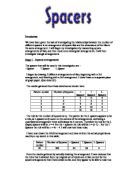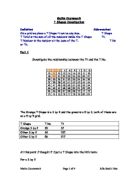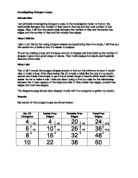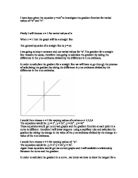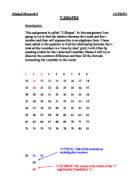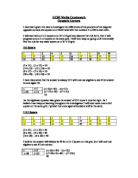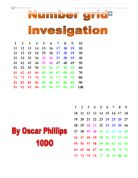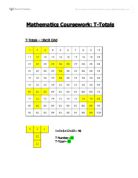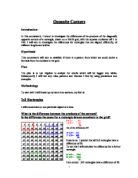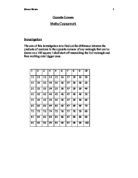Review on short trip to Paris.
Review on short trip to Paris. After an hour and a half flight from Dublin - Beauvais, we took the Coach from Beauvais to the heart of Paris. This cost 20£ return for an hour trip which seemed fair enough, this being part of an agreement with Michael O'Learys, Ryanair to bring his Passengers to Paris from the airport. We arrived at the hotel (High tech montmartre 3***) around 2:00pm and were taken to our rooms via the porter, I'm gonna be very critical of this hotel, as soon as we entered our room the stench out of our toilet was disgusting and it was to remain there for the duration of our stay, I found the staff friendly enough. The selection of breakfast was basic and it probably justified its 3*** rating. The Area, which we stayed in, was very close to Place de Clichy, which is a red light district, I dare not stay out later than 9 o clock in fear of any illegal activity in the area. Place de Clichy was not a rough area but it wasn't a classy place either, nothing like the L'arc de Triomphe, where I found it very clean and friendly looking, but there was always that chance that pick pockets were lurking around. Monday afternoon we took a trip to the Eiffel tower, where I must say that it was well worth the visit. We went to the very top and the views were simply exquisite you could see from miles and miles away, the tower was huge and judging by previous pictures I
The relationships between the number of different spacers in an arrangement of square tiles and the dimensions of the tiles in the same arrangement.
Introduction We have been given the task of investigating the relationships between the number of different spacers in an arrangement of square tiles and the dimensions of the tiles in the same arrangement. I will begin my investigation by researching square arrangements of tiles, and then move onto rectangular arrangements. I will then investigate triangle arrangements. Stage 1 - Square arrangements The spacers that will be used in this investigation are - + Spacer T Spacer L Spacer I began by drawing 5 different arrangements of tiles, beginning with a 1x1 arrangement, and finishing with a 5x5 arrangement. I drew these on a separate piece of graph paper. (See sheet S1). The results gathered from these sketches are shown here: Pattern number Number of Squares + Spacers T Spacers L Spacers 0 0 4 2 4 4 4 3 9 4 8 4 4 6 9 2 4 5 25 6 6 4 The rule for the number of squares is xy. The pattern for the L spacers appears to be a rule, as L spacers only occur on the corners of the arrangements, and being a quadrilateral arrangement there will always be 4 corners. Therefore the rule for the L shaped spacers will be n = 4. For the + spacers the rule will be n = (n-1) . For the T Spacers the rule will be n = 4n - 4. I will now test these rules. I have now drawn the 10x10 arrangement and have written the actual properties as read from my sketch in this
Is there maths behind M.C. Escher’s work? If so, what elements are there?
Is there maths behind M.C. Escher's work? If so, what elements are there? In this essay, before I start anything, I must first clarify that I deeply consider mathematics as a subject that has had a great influence on the artist and his masterpieces, therefore I already alarm you that throughout my essay I will talk about Escher's work and try to persuade you that there has been a considerable integration of the subject matter with his very artworks. In order to make you understand my objective, I have gathered some of his work, then selected a few, which I found had more mathematical elements, then with a decreased amount of drawings to work with, I would be able to study all components and show you that there has been a great influence of maths on him. I believe these images without the existence of any mathematical aspect would not be able to be fully accomplished. Elements like: symmetry (reflection also included), pattern/tessellation (repetition), transformation, crystallography, "impossible shapes", proportion and the 'Fibonacci Sequence' or the 'Golden Ratio'. Are suggested to be present in M.C. Escher's artworks, these I believe have been responsible to create the effect they create on the viewer, which is wonder and marvellous of the impressive art that cannot belong to the real world. Later on I will mention and try to explain these components, so that a random
Number Stairs Investigation
Number Stairs Investigation 91 92 93 94 95 96 97 98 99 00 81 82 83 84 85 86 87 88 89 90 71 72 73 74 75 76 77 78 79 80 61 62 63 64 65 66 67 68 69 70 51 52 53 54 55 56 57 58 59 60 41 42 43 44 45 46 47 48 49 50 31 32 33 34 35 36 37 38 39 40 21 22 23 24 25 26 27 28 29 30 1 2 3 4 5 6 7 8 9 20 2 3 4 5 6 7 8 9 0 lowest number (n) Long operation Total (t) st Difference (D0) + 2 + 3 + 11 + 12 + 21 50 6 2 2 + 3 + 4 + 12 + 13 + 22 56 6 3 3 + 4 + 5 + 13 + 14 + 23 62 6 4 4 + 5 + 6 + 14 + 15 + 24 68 6 5 5 + 6 + 7 + 15 + 16 + 25 74 6 Judging by this, the first part of the overall equation for a 3 step stair is 6n +? n 6n T D0 6 50 44 2 2 56 44 3 8 62 44 4 24 68 44 5 30 74 44 This shows the difference between 6n and T as + 44 Therefore the equation for a 3 step stair on a 10x10 grid is 6n + 44 The same sequence can be used for a 4 step stair lowest number (n) Long operation Total (t) st Difference (D0) + 2 + 3 + 4 + 11 + 12 + 13 + 21 + 22 + 31 20 0 2 2 + 3 + 4 + 5 + 12 + 13 + 14 + 22 + 23 + 32 30 0 3 3 + 4 + 5 + 6 + 13 + 14 + 15 + 23 + 24 + 33 40 0 4 4 + 5 + 6 + 7 + 14 + 15 + 16 + 24 + 25 + 34 50 0 5 5 + 6 + 7 + 8 + 15 + 16 + 17 + 25 + 26 + 35 60 0 n 0n T D0 0 20 10 2 20 30 10 3 30 40 10 4 40 50 10 5
Investigate the difference of the product of the diagonally opposite corners of a certain shape, drawn on a 10x10 grid with the individual squares numbered off 1 to 100.
Maths Coursework Aim: I task is to investigate the difference of the product of the diagonally opposite corners of a certain shape, drawn on a 10x10 grid with the individual squares numbered off 1 to 100 I will start off by working this out on a 2x2 square and from there I will begin to investigate varying the length and width of rectangles and other squares. I will aim to investigate the differences for different sized rectangles and squares that are aligned differently on the grid. I will record findings and ideas as I proceed. Method: To make things easier for me I will break up each investigation in to sections, I will start with: 2x2 square I will concentrate on one particular aspect at a time. * What is the difference between the products of the corners? * Is the difference the same for a square or rectangle the same shape anywhere on the grid? 2 3 4 5 6 7 8 9 0 1 2 3 4 5 6 7 8 9 20 21 22 23 24 25 26 27 28 29 30 31 32 33 34 35 36 37 38 39 40 41 42 43 44 45 46 47 48 49 50 51 52 53 54 55 56 57 58 59 60 61 62 63 64 65 66 67 68 69 70 71 72 73 74 75 76 77 78 79 80 81 82 83 84 85 86 87 88 89 90 91 92 93 94 95 96 97 98 99 00 2 x 11 = 22 x 12 = 12 Diff = 10 Are all the differences 10? 46 x 55 = 2,530 45 x 56 = 2,520 Diff = 10 It seems so. I now predict
T Shapes Investigation
Maths Coursework T Shapes Investigation Definition Abbreviation: On a grid we place a T Shape it can be any size. T Shape T Total is the sum of all the numbers inside the T Shape Tt. T Number is the number at the base of the T. T No or Tn. Part 1 Investigate the relationship between the Tt and the T No. 2 3 4 5 6 7 8 9 0 1 2 3 4 5 6 7 8 9 20 21 22 23 24 25 26 27 28 29 30 31 32 33 34 35 36 37 38 39 40 41 42 43 44 45 46 47 48 49 50 51 52 53 54 55 56 57 58 59 60 61 62 63 64 65 66 67 68 69 70 71 72 73 74 75 76 77 78 79 80 81 The Orange T Shape is a 3 by 2 and the green is a 5 by 3, both of these are on a 9 by 9 grid. T Shape T No Tt Orange 3 by 2 20 37 Other 3 by 2 34 107 Other 3 by 2 56 217 At this point I thought if I put a T Shape into the Nth term: For a 3 by 2 2 3 1 20 Goes to n-19 n-18 n-17 n-9 n = 5n-63 Therefore to make it a formula it becomes Tt=5n-63 Now I began to explore how to find certain numbers such as the 5 and the minus 63. The only numbers I can work with are the 3 and the 2 from the t shape, the 9 from the grid. So the obvious way to get the 5 is from the t shape. So the 3 we call the T width or W. And the 2 is the t height or H Now we have Tt = (H+W)n-63 Next I tested this out with a 3 by 2 t shape, with a T No of 20 Tt =
Investigating Octagon Loops
Investigating Octagon Loops Introduction I am primarily investigating Octagon Loops. In the investigation I plan to find out the relationship between the number of tiles used in the loop and the total number of free edges. Also, I will find the relationship between the number of tiles and the inside free edges and the number of tiles and the outside free edges. What I Will Do I plan to do this by first using octagon shapes and positioning them into loops, I will then put the results into a table so that it's easier to analyse. I'll start by making a loop with the least amount of shapes and then build up the number of shapes to give me a good range of values. Then I will analyse the results and hopefully discover some rules. What I did First of all I moved the octagon shapes around to find out the minimum amount it would take to make a loop. After discovering this (4) I made a table like the one in my results section and made more loops to get a more varied range of results which would make it easier for me to make a rule. I then set about trying to find out rules for the relationship between the 4 main aspects of the loops (number of tiles, inside free edges, outside free edges and total free edges). The diagrams page shows what shapes I made with the octagons to gather my results. Results My results for the octagon loops are shown below: No. Of Octagons Inside
Borders Maths Coursework
Borders Maths Coursework Here we are look at what happens when you put a (square) border on each side of the original shape. Me starting point will have no borders When I add the borders I put them on each side of the first square and there are 4 borders With the next shape there are now 8 borders. With this shape there are now 12 borders. This shape has 16 borders I can now see a pattern in the number of square, which is that there are 4 more each time. Here is a table to show what I have found. Number of black squares Number of white squares 4 5 8 3 2 25 6 41 20 61 24 Using this I can guess what the next number of white squares will be 20. A you can see there are 20 white cubes. This shape has 24 borders Now I will try to find the nth term for the white cubes (Borders). 1st 2nd 3rd 4th 5th 6th 4 8 12 16 20 24 4 4 4 4 4 The nth term for this is 4n so I wanted to work out how many borders there are the 10th shape I will times 4 by 10 and the number of borders will be 40 Now I will work out the nth term for all the squares in the pictures. Number of square 5 3 25 41 st 2nd 3rd 4th 5 13 25 41 st 8 12 16 2nd 4 4 The nth term for all the cubes is 22n-1. The 10th number will be worked out by 4 times 10 minus 1 which is
I have been given the equation y = axn to investigate the gradient function for varied values of "a" and "n".
I have been given the equation y = axn to investigate the gradient function for varied values of "a" and "n" Firstly I will choose n = 1 for varied values of a When n = 1 then the graph will be a straight line The general equation of a straight line is y = ax I am going to keep n constant and use varied values for "a".The gradient for a straight line remains the same, therefore I am going to calculate the gradient by taking the difference in the y co-ordinates divided by the difference in x co-ordinates. In order to calculate the gradient for a straight line we will have to go through the process of calculating the gradient by taking the difference in y co-ordinates divided by the difference in the x co-ordinates. I would then choose n = 2 for varying values of a where a = 1,2,3,4 The equations would be ; y = x2 , y = 2x2 , y = 3x2 , y = 4x2 These equations would get us curved graphs and the gradient function at each point in a curve is different therefore I will draw tangents using a capillary tube and calculate the gradient by taking the change in the value of the y co ordinates divided by the change in t value of the x co ordinates. I would then choose n = 3 for varying values of "a". The equations would be ; y = x3, y = 2x3,y = 3x3. Again these equations would get me curved graphs and I will establish a relationship Between the curve and the
In this assignment I am going to try to find the relation between the t-total and the t-number and then will express this in an algebraic form. I have been asked in the question to find the relationship between the t-total ad the t-number in a nine by
Abdul Khan W3 16/06/01 T-SHAPES Introduction This assignment is called 'T-Shapes'. In this assignment I am going to try to find the relation between the t-total and the t-number and then will express this in an algebraic form. I have been asked in the question to find the relationship between the t-total ad the t-number in a 'nine by nine' grid; I will d this by creating a table for the t-total and t-number. Hence I will try to discover the common difference and then fid the formula connecting the t-number to the t-total. 2 3 4 5 6 7 8 9 0 11 12 13 14 15 16 17 18 9 20 21 22 23 24 25 26 27 28 29 30 31 32 33 34 35 36 37 38 39 40 41 42 43 44 45 46 47 48 49 50 51 52 53 54 55 56 57 58 59 60 61 62 63 64 65 66 67 68 69 70 71 72 73 74 75 75 76 78 79 80 81 'T-TOTAL' Add all the numbers up including the t-number. 50 51 52 60 'T-NUMBER' The number at the bottom of the 'T' 69 algebraically Classified an 'n' I am investigating the relationship between the t-total and the t-number. 37 20 42 21 47 22 52 23 57 24 62 25 67 26 72 27 77 28 82 29 Pattern: I have noticed a pattern in my results that each time the t-number increases by 1 the t-total increases by 5. I know that; As 5 is the most common difference the must be a '5n' in the formula. 22 23 24 32 41 Un



